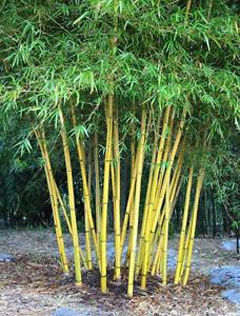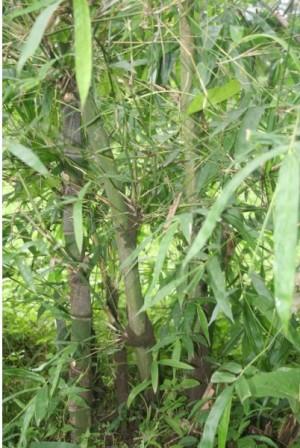



Bambusa nutans is an evergreen or deciduous, clump-forming bamboo with fairly thick-walled culms reaching a height of 6 - 15 metres, with canes 5 - 10cm in diameter. One of the six main species commonly used in the Indian paper industry, it is widely cultivated as a source of materials in India, Bangladesh and Thailand. A graceful bamboo, it is worth growing as an ornamental.
Mostly confined to Himachal and other North Eastern states. Also grows well in Orissa,Sikkim,Uttar Pradesh,West Bengal.Can also be grown in South Indian states of Kerala, and parts of Karnataka.
Natural Regeneration Propagated by seed. Artificial Regeneration Propagated by direct sowing, offset planting. Seed collection Storage Seeds are available for a few years after gregarious flowering if stored under right conditions. Seeds have no dormancy and help to utilize the favorable condition after seed fall. Flowering occurs in the period of 35-45 years. Gregarious flowering spread over 2-3 years, Pretreatment The seeds should be soaked in cold water for 24 hours. Nursery Technique Seeds can be sown directly on nursery beds during March-May in patches and cover lightly with soil. If fresh seeds are sown 90 to 100 percent germination can be achieved. Partial shade is necessary for initial establishment of seedlings. The seedlings can be poly-potted after 45 days. Large scale production can be achieved through macro proliferation. Offset planting: It can be done during the onset of monsoon but this method is expensive for transportation and rhizome extraction as it is difficult. This species is also propagated through culm cutting and branch cuttings after treated with growth regulating hormone.
Season of planting- Planting during the pre monsoon showers ensures better survival and quicker field establishment Pre planting operations Demarcation and fencing to be completed at least three months prior to planting. Weeding to be completed at least 15 days prior to planting. Pit size & treatment 45 X 45 X 45 cm cubical pits to be half filled and kept exposed to sun for top soil sterilization for about a month. Planting Along with the pre monsoon showers, the pits are to be completely filled and planted with one year old planting stock. The filled up soil to be compacted around the plant. Spacing Closer spacing of 6 X 6 m Is ideal.
Irrigation Responds well to irrigation however essential only during the first one or two years so as to ensure better establishment and quicker culm production. Moisture retention through trenches to be practiced. Thinning Regular thinning of the older culms and cleaning should be carried out from the 4th year of clump establishment. All dry, dead and drying culms are to be removed from the clump so as to43 provide sufficient space in the clump for new sprouts. Branch pruning also provides sufficient space for the emerging culms to grow upwards quickly without any hindrance. As a regular practice these operations are to be carried out every year probably prior to the winter months. Cultural practices All dead and dying culms to be cut and removed from the third year of establishment. Thorns to be pruned from the base of the clump every year preferably in the months of November –December. Rot of culms The infection causes rot of the tender, succulent emerging shoot, which becomes discoloured, and gives off a strong smell of molasses. The disease control can be achieved by taking preventive measures (spraying insecticide, Monocrotophos 0.05 % a.i.) against build-up of Purohita cervina population during the culm elongation phase and by application of fungicide Carbendazim (Bavistin) or Mancozeb (Dithane M 45) at 0.2 % a.i. on the infected culms.Bamboo blight: Application of Carbendazim (Bavistin) combined with Mancozeb.
In bamboo planting, irrigation should be carried out frequently while they are grown on nursery beds. Immediate irrigation should be given at the time of transplanting seedlings from nursery to main field. As bamboo trees are sensitive to water logging, make sure to drain out the soil in case of heavy rains or flooding. Subsequent irrigations depend on the soil moisture holding and climatic conditions. It’s preferred to let a plant go a little dry and water it. A drip irrigation system can be adopted for better utilization of water. Over watering will make the tips of leaves to turn into brown.
daily increases in height of 30cm or more
Agroforestry Uses: The plant is sometimes used to provide shelter for tea plantations. Bamboo : The culm is good, strong, straight. It is used locally for various purposes, mainly as pole. It is a major source of fibre for the paper industry in India. The brood from the infestation of khair with kusum brood takes very well when used to infect kusum again in January-February. The resulting lac is of good quality.
Gum: The gum from khair is said to be of very good quality and is regarded as the best substitute for true gum arabic. The tears may be as large as 3 cm in diameter and pale yellow to dark amber in colour. It is not collected separately and is generally mixed up with other Acacia gums.